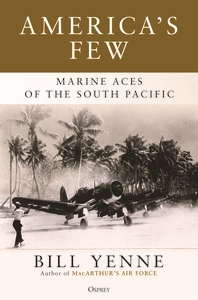In today's blog post, Bill Yenne, author of America’s Few: Marine Aces of the South Pacific, gives a brief overview of the book and what inspired him to tell this story.
They were America’s Few, this handful of US Marine Corps aviators.
The term “Few” is, of course, borrowed from Winston Churchill’s iconic characterization of the outnumbered fighter pilots of the Royal Air Force who saved Britain from Hitler’s war machine in 1940.
The British Few of 1940 and the American Few of 1942 were alike in that they happened to be in the right place at the right time to curb the invincibility of an Axis foe. For the American Few in the fall of 1942, the right place was a small, obscure South Pacific island called Guadalcanal, familiar to almost no one in the outside world, and which no one could have predicted would be the venue of a turning point in world history.
There were also differences between Churchill’s Few and those who are described by that term by me in this book. The Few of the RAF fought to save their own land from a rumbling Blitzkrieg that was literally within sight of their doorstep. The Marine Few fought a rampaging monster thousands of miles from their own doorstep. This monster was the war machine of Imperial Japan, which raged unchecked across the Far East and the Western Pacific in 1942, a war machine described by me in my earlier book for Osprey, The Imperial Japanese Army: The Invincible Years (2014).
Strategically, the stakes were high. For Churchill’s Few, it was a millennium of British civilization. For America’s Few, it was stopping the advance of an Axis enemy that already controlled the lives of millions across China, Southeast Asia and the East Indies. A failure to stop Japan’s advances in 1942 would have meant the virtual isolation—and possibly the fear of invasion — of Australia and a status quo of brutal Japanese imperial rule across Asia that may well have prevailed for generations.
This is not a story of grand strategy. Those have been written, some of them magnificently. These are stories of individual battles, one-on-one battles, battles of the most personal kind. These are the stories of individual lives, the individual lives of a unique group of men.
Among the stories are those of the three men recognized as the Marines with the highest tally of aerial victories, which area study in contrasts. Gregory Boyington and Joseph Jacob Foss were both born in the West when it was barely out of its Wild West phase of development. Robert Murray Hanson was born in India, the son of missionaries.
Each of this trio earned the Medal of Honor. Foss and Boyington became household names during the war and remained as such for decades thereafter. Foss became Governor of South Dakota and played a role in the creation of the Super Bowl. Boyington became a “love-him-or-hate-him” bad boy, cursed by substance abuse, who wound up with his story turned into a television drama series that aired for two seasons, making him a household name. Hanson, who was killed in action in 1944, never had a postwar career that would help to define his legacy, and he is today largely forgotten.
What inspired me to write the book?
I have always had an interest in air aces and aerial combat, and I’ve written several other books about aces. Aces are inspiring because they present an image of the lone warrior that is unique to the twentieth century. It is an image that arouses the imagination and paints warfare not as hell but as glorious. The ace, like the knight of European legend or the gunfighter of American legend, is not lost among the anonymous dead, but preserved as an individual for posterity.
Meanwhile, I have a personal connection to the times and places of the early lives of Foss and Boyington. My mother was born in South Dakota a few years before Foss, and while he was growing up outside Sioux Falls, she was growing up a half-day’s drive away on a gravel road in Highmore. While Boyington was in his teens in St. Maries, Idaho, my father was working as a packer for the US Forest Service in the St.Joe National Forest. St. Maries was the hub of activity for the Forest Service in that part of Idaho. They may well have crossed paths.
Intrigued by the book? America's Few is out now and available to order on our website.


Comments
You must be logged in to comment on this post. Click here to log in.
Submit your comment